#Charles Vinick
Text

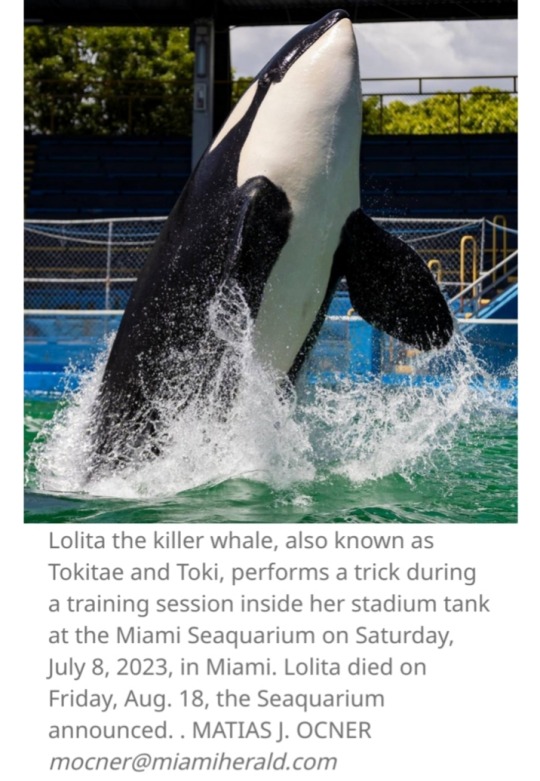
Lolita, the orca that was a star attraction in captivity at the Seaquarium, died Friday as plans to move her out of the Miami theme park were beginning to take shape.
She was believed to be 57 at the time of her death.
Now known as Toki, a name adopted by advocates urging her freedom, the killer whale had suffered health problems in her Seaquarium tank last fall before seeming to recover, according to recent interviews with her training staff.
In a social media post, the Seaquarium said Lolita developed a renal condition in recent days.
“Toki was an inspiration to all who had the fortune to hear her story, and especially to the Lummi nation that considered her family,” the statement said, referring to indigenous people in her natural waters off Washington state, where she was captured at age four.
A non-profit backed by Jim Irsay, owner of the Indianapolis Colts, had been partnering with the Seaquarium to move Lolita to a sea pen off Washington state and was training her for the eventual move.

The non-profit, Friends of Toki, released the same statement as the Seaquarium, with some details about her failing health:
“Over the last two days, Toki started exhibiting serious signs of discomfort, which her full Miami Seaquarium and Friends of Toki medical team began treating immediately and aggressively.
Despite receiving the best possible medical care, she passed away Friday afternoon from what is believed to be a renal condition.”
Toki was a shortened version of Tokitae, the name given the orca by indigenous people in Washington state, who have for years advocated to return the mammal to her native waters.
Friends of Toki was in talks with tribes in Washington to assist with the plan to transfer Lolita to the pen, where she would continue being fed and given medical care but with far more room to swim amid natural waters with sea life traveling in and out of the netting.

Some of her handlers in Miami planned to move to Washington to remain working with Lolita after the relocation in an ongoing care operation funded by Friends of Toki, Charles Vinick, the group’s director, said in a recent interview.
“All who want to, we’d want to move with her,” he said. “They’re the people she trusts.”
Friends of Toki had paid to upgrade the chilling equipment in Lolita’s Seaquarium tank.
They hired a trainer, veterinarian and others to help supervise her care and training.
That included introducing the car-sized sling that was planned to hoist her out of the tank and onto a transport truck for a cross-country flight to Washington for a new life in a sea pen.
‘Heartbroken’
“I am heartbroken that Toki has left us,” Irsay said in a statement. “I was honored to be part of the team working to return her to her indigenous home, and I take solace in knowing we significantly improved her living conditions this past year.”
The relocation plan was mostly aspirational, since the Irsay group hadn’t secured the federal permits or water rights needed to create a sea pen for the 7,000-pound mammal.
But it was the most definitive effort yet to move Lolita from a tank that had been flagged by federal animal inspectors and local authorities as needing a major overhaul to continue housing Lolita.
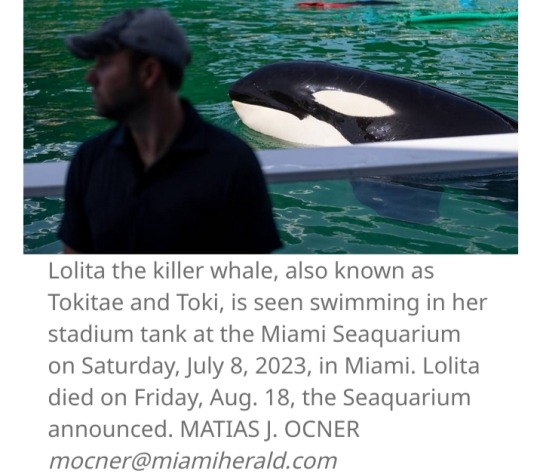
While the Seaquarium continues holding dolphin performances, the Lolita shows ended in 2021 as the condition of the tank drew scrutiny from the United States Department of Agriculture and Miami-Dade’s Unsafe Structures Division.
When the Dolphin Company purchased the Seaquarium operations in 2022, including the site lease for the county-owned waterfront that houses the park, it announced Lolita would never return to public performing.
Animal-rights activists condemned the Seaquarium over the years for confining the orca in a tank small enough that it took just seconds to swim from end to end.
“Kind people begged the Miami Seaquarium to end Lolita’s hellish life in a concrete cell and release her to a seaside sanctuary, where she could dive deep, feel the ocean’s currents, and even be reunited with the orca believed to be her mother,” PETA, an anti-captivity group, said in a statement.
“But plans to move her to a seaside sanctuary came too late.”
The relocation plan had critics, too. Some former trainers of Lolita formed Truth4Toki and urged the Seaquarium to either keep the orca in place or move her to a more modernized tank at Sea World in Orlando.
After past battles with illness, the group said Lolita “is not a candidate for release.”
Tom Reidarson, a former SeaWorld veterinarian hired by Friends of Toki to work with her in Miami, said in a recent interview that he was concerned Lolita would die last fall after a serious bout with pneumonia.
“It became pretty dire,” he told the Miami Herald on July 8.
Though she remained on antibiotics, Reidarson said the orca’s lung problems appeared to have resolved well.
“She’s actually really healthy right now,” he said.

In its statement, the Seaquarium described liver issues with Lolita, who was believed to be four when captured in Puget Sound and roughly 57 in 2023.
“Over the last two days, Toki started exhibiting serious signs of discomfort,” the Seaquarium said on X, the site formerly known as Twitter.
“Despite receiving the best possible medical care, she passed away Friday afternoon from what’s believed to be a renal condition.”
Miami-Dade’s mayor, Daniella Levine Cava, advocated for moving Lolita as part of the county’s talks with the Dolphin Company taking over the lease.
The company signed an agreement to move the orca once there was a safe and healthy option for her to leave the Seaquarium.
“Our collective wish was to see Toki in her native waters and we are heartbroken to learn of this sudden loss,” Levine Cava said in a statement.
“Alongside the many Miamians who grew up visiting her, the generations of activists around the world that were inspired by her story, and the caretakers who remained dedicated to her health until the very end — today we say our final goodbye to our beloved Toki.”
This story was originally published on August 18, 2023.
🖤🤍🖤
#Lolita#Toki#Tokitae#orca#killer whale#Miami Seaquarium#Jim Irsay#Indianapolis Colts#Friends of Toki#Charles Vinick#United States Department of Agriculture#Miami-Dade’s Unsafe Structures Division#Dolphin Company#PETA#Truth4Toki#Tom Reidarson#Daniella Levine Cava#Miami-Dade
3 notes
·
View notes
Text
Nova Scotia's retirement home for captive whales facing obstacles, delays: documents
An ambitious plan in Nova Scotia to build North America's first coastal refuge for captive whales is at least five years behind its original schedule, newly released documents show.
The project, announced in February 2020, calls for construction of a 40-hectare underwater enclosure that would provide a natural environment for beluga and orca whales retired from marine parks. It would be as large as 50 football fields and about 300 times larger than the biggest captive whale tanks.
Organizers behind the U.S.-based Whale Sanctuary Project had originally predicted the site on Nova Scotia's rugged eastern shore could be ready to receive whales this year.
But the COVID-19 pandemic, regulatory hurdles and environmental concerns have slowed the project's progress, according to documents obtained by The Canadian Press under the province's freedom of information law.
An internal government presentation prepared in May 2021 says that once the project is granted a Crown lease for a small cove and some land south of Port Hilford, N.S., it would take at least another five years before the site is ready to accept whales. That pushes the start date to 2027.
Charles Vinick, executive director of the non-profit Whale Sanctuary Project, said the government's timeline is flawed because it includes construction of an interpretive centre, which won't happen until after the whales arrive. The group's own timeline now has a late 2023 start date, though Vinick said 2024 is more likely.
The pandemic is largely to blame for slowing down the project, but Vinick also pointed to a demanding provincial permitting process.
"It's brand new ground for them and brand new ground for us," he said in an interview from his home in Santa Barbara, Calif. "We have to focus on moving forward every day."
As an example, he cited his group's plan to extract small core samples from submerged soils for testing. A permit application was filed in April, but it took almost five months for the Department of Natural Resources to decide that an archeological assessment was required before the testing could start.
"These things do come up, and I suspect there will be more," Vinick said. "But every time one comes up, we're going to do it."
The documents also point to serious concerns about 20 abandoned mine shafts and contaminated tailings left behind from nearby gold mines that operated between 1862 and 1900.
The sanctuary project says recent work has identified some shafts that remain unfilled on or near land that the project plans to occupy, and soils throughout the property have been analyzed. More testing will determine whether any areas require mitigation.
"All mitigation requirements that will be assessed, we will meet," Vinick said. "We're not going to do anything to jeopardize the health of the whales."
On another front, the documents show that Nova Scotia's Environment Department was concerned about nearby wetlands, and the federal Department of Fisheries wanted to know what kind of animals would be admitted to the refuge to allow officials to prepare for disease mitigation and an application under the Species at Risk Act.
As for the 40-hectare enclosure -- to be surrounded by underwater nets -- it will be designed to hold eight to 10 beluga whales and two to three orcas in a separate area. The animals will not be returned to the wild because of their lack of survival skills.
The $20-million project, which will rely on private donations for support, also calls for the construction of a veterinary clinic, observation tower and other support buildings. Another $2 million would be needed annually for operations. A visitor centre was opened last year.
About 200 belugas and 50 orcas are being kept in marine parks and aquariums around the world. The Marineland Park in Niagara Falls, Ont., has about 35 belugas and Canada's lone captive killer whale, Kiska.
"None of this work can happen soon enough for the whales who are languishing in concrete tanks and are subject to intolerable conditions," the group said in an online post last month.
"Yet it is essential to get everything right for the health and safety of those very whales when they are introduced to an entirely new life. It is also the law."
This report by The Canadian Press was first published Oct. 23, 2022.
from CTV News - Atlantic https://ift.tt/65YyOP9
0 notes
Link
0 notes
Link
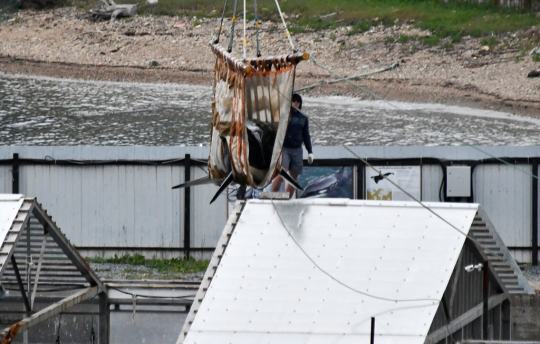
An orca is hoisted from the water in Srednyaya Bay, in far eastern Russia, on Thursday, one of almost 100 captive whales set to be transported and released. Credit: Yuri Maltsev/Reuters
Excerpt from this New York Times story:
Russia on Thursday started the process of releasing almost 100 valuable orcas and belugas that have been held for months in what became known as the “whale jail” in the country’s Far East, following an international outcry and intervention by President Vladimir V. Putin.
The movement of the first batch of two orcas and six belugas was first broadcast during Mr. Putin’s annual call-in show on Thursday, highlighting his role as a modern, televised czar, ready to solve any issue, big or small.
The first eight animals were moved from the watery pens where they were forced to spend almost eight months to water reservoirs installed in trucks. They will spend six days traversing more than 1,100 miles to reach the Shantar Islands in the Sea of Okhotsk, the area where they were caught last year.
This route was not the only option considered by the Russian authorities. The initial decision was to release them where they were held in captivity, farther south along Russia’s Pacific coast.
An international group of scientists and marine mammal specialists, which included Jean-Michel Cousteau of the Ocean Futures Society and Charles Vinick, the executive director of the Whale Sanctuary Project, pleaded with the government to choose the more costly option of releasing them in their natural habitat, where they were caught.
The whales were initially captured by four private companies linked to one man. The companies used loopholes in Russian law to obtain permits to catch animals and then sell them to China, where they would spend their lives performing in theme parks.
The whales are going to be released in groups from June until October, the Russian government’s Fisheries and Oceanography Institute said in a statement. They will be monitored by 70 specialists, including veterinary doctors and scientists. Each whale will be accompanied by two people and will be equipped with a GPS tracker before release.
16 notes
·
View notes
Photo
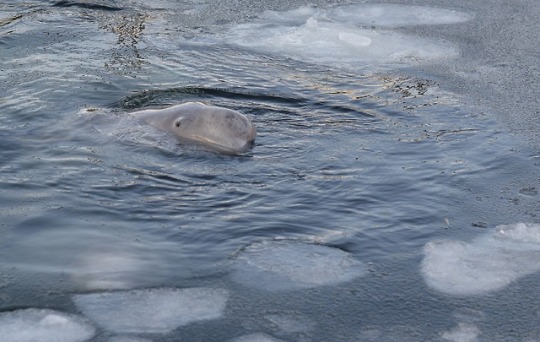
BREAKING NEWS: RUSSIAN GOVERNMENT COMMITS TO RELEASING CAPTIVE ORCAS AND BELUGA WHALES
Mark J. Palmer - February 10, 2019
We have just heard that the Russian government has issued a statement indicating that they will likely move soon to release 11 orcas and 87 beluga whales from sea pens, where they have been kept captive in the east coast Bay of Srednyya, south of Vladivostok, since being caught last summer in the Russian Sea of Okhotsk.
Originally, these animals were caught by four Russian companies (that are linked, according to reports) for sale to aquariums in China. The government declared the permits issued to be illegal and blocked the sale and export to China, and have further denied issuing new permits to capture cetaceans in 2019.
The International Marine Mammal Project (IMMP) of Earth Island Institute has been working with Russian conservationists on the problem of captures of wild orcas and beluga whales for captivity for several years.
“Through hard work in Russia and around the world, the illegal captures of orcas and belugas being held in Russia have been stopped and their sale to China cancelled.” stated David Phillips, Director of IMMP. “Now the final critical step of returning this huge group of orcas and belugas to the ocean is looking likely to proceed. This would be a spectacular breakthrough, ending a cruel and calamitous capture operation.”
The Head of the Ministry of Natural Resources, Dmitry Kobylkin, made the announcement on Friday, Feb. 8th.
Mr. Kobylkin stated: “We have done a lot of work with various departments. The attention of caring public, ecologists, residents of the region was very import. Today, there is every reason to assert that the release of marine mammals – hostages of the situation in the Bay of Srednyya in Primorsky Krai, will occur in the very near future. The interdepartmental working group, together with experts, scientists will give an opinion on the phasing of the release after examination of the animals.”
The inspections will take place by the State Inspectors of Rosprirodnadzor (The Federal Service for Supervision of Use of Natural Resources), together with representatives of the Amur Basin Environmental Prosecutor’s Office, the Investigative Committee for the Khabarovsk Territory and experts from research institutes.
It is not clear yet whether Western scientists and experts might be brought in to consult with Russian government scientists, as generally Russians have little experience with live release of captive cetaceans.
IMMP coordinated a January 31st letter to Russian President Vladimir Putin signed by Jean-Michele Cousteau, Dr. Roger Payne, Charles Vinick and IMMP Director David Phillips, offering to help the Russian government free the whales, as all of the signers worked with Keiko, the orca whale and star of the hit movie “Free Willy”, to successfully return him to the wild in Iceland.
Nor is it clear just how the releases will be done. In addition to cuts and scarring from ice damage and frostbite visible on orcas in the sea pens, some of the beluga whales were not weaned when they were captured and may still be dependent on milk. The quality of the water in the sea pens is quite poor, showing high bacterial counts and over-crowding. So some of the whales may not be able to be released, but it is unclear what is to be done with them until they can be rehabilitated, given the poor quality of the sea pen facility. See: http://savedolphins.eii.org/news/entry/first-photos-and-inspection-of-russias-whale-prison-raises-alarm
The companies that caught the whales are in trouble with Russian prosecutors. Cetaceans can be kept in captivity in Russia only for purposes of scientific research and public education, not sale to China. And a second case is reportedly being opened over the degraded water quality found in the sea pens.
IMMP and our Russian colleagues will continue to push for an end to the captivity trade of wild orcas and beluga whales in Russia and urge the government to release the animals currently in the “whale prison” as soon as possible.
#news#captivity#release#cetacean#whale#dolphin#orca#killer whale#beluga#russia#marine mammal trade#animal trade#captures#wild
18 notes
·
View notes
Text
Freeing Orcas and Belugas from the "Whale Jail"
Freeing Orcas and Belugas from the “Whale Jail”
Twelve of the #belugas and all ten of the #orcas held in the “whale jail” in Russia’s Srednyaya Bay have been released. Find out how these whales are doing now that they’re swimming in the open ocean for the first time in almost a year from Charles Vinick, director of the Whale Sanctuary Project, who stepped forward to help secure their release along with his friend Jean Michel Cousteau. ⠀#oceanx
View On WordPress
0 notes
Text
Russia Frees Last Belugas from Notorious ‘Whale Jail’
https://sciencespies.com/news/russia-frees-last-belugas-from-notorious-whale-jail/
Russia Frees Last Belugas from Notorious ‘Whale Jail’
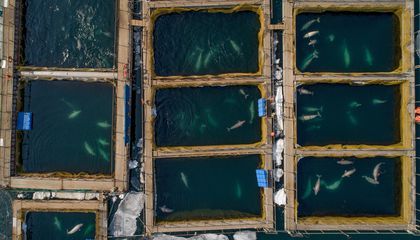
In late 2018, disturbing drone footage of dozens of orcas and belugas, packed into small pens in Russia’s far east, came to international attention. The outcry was swift, prompting intervention by Russian President Vladimir Putin. Now, after a months-long release operation, the last cetaceans have been freed from “whale jail,” as the notorious facility was dubbed, according to Agence France-Presse.
The whales—87 belugas and 11 orcas—had been held in Srednyaya Bay, captured by “four private companies linked to one man,” as Ivan Nechepurenko of the New York Times reported in June. Starting in the summer, officials began releasing the animals in batches, with the last of the orcas set free in June. The final 21 belugas were released from two ships on Sunday, according to the AFP.
The whales were reportedly due to be sold to theme parks in China. Though keeping whales and dolphins in captivity at entertainment facilities has fallen out of favor in some parts of the world, the practice continues to thrive in China. According to the Whale Sanctuary Project, around 950 cetaceans are currently on display in the country, many of them imported from Japan and Russia.
After journalists and activists alerted the public to the situation in Srednyaya Bay, Putin directed a special commission to determine what should be done with the animals. Russian scientists and government officials visited the whales to assess their condition—which was not good. “Many of the orcas showed skin damage, presumably from frostbite and contact with the sharp ice that forms in the sea pens, despite the efforts of the staff of the sea pens to keep the pens clear of ice,” the International Marine Mammal Project revealed. Orcas, for example, are not typically exposed to sea ice in their native habitat.




An aerial view of pools where illegally caught 11 orcas and 90 belugas were kept.
((Photo by Yuri SmityukTASS via Getty Images)
More
And no cetacean is “used to being held in a 12-by-10-meter [space] with men crashing shovels over their heads,” Dmitry Lisitsyn, head of the Russian NGO Sakhalin Environment Watch, told Natasha Daly and Maria Antonova of National Geographic in April. All of the belugas, among them 15 babies who likely had not been weaned from their mothers’ milk when they were captured, appeared to be in distress, Lisitsyn added.
Yet a report by the Whale Sanctuary Project and Jean-Michel Cousteau of the Ocean Futures Society revealed that the orcas and belugas appeared to be well fed, and they received only minimal training. Therefore, the animals exhibited “no indicators suggesting that they cannot be released into the wild after appropriate short-term medical and behavioral rehabilitation.”
Putin personally monitored the initial phases of the operation to transport the whales out of the pens, Daly reports. And Russian Deputy Prime Minister Alexey Gordeyev promised that the country would tighten a law that allows cetaceans to be held for “scientific and educational purposes”—a loophole that the four companies were exploiting to legally capture the animals for sale to facilities in China. A Russian court ultimately ruled that the companies’ permits to capture the whales were not in fact legal, and all of them were required to pay large fines.
But according to the AFP, activists and scientists have criticized Russian officials for their handling of the rescue mission—particularly, for “keeping the details of the release secret, not taking any observers on the trip and freeing only a small group of animals at a time rather than all of them together, which would boost their survival odds.”
Jean-Michel Cousteau and Charles Vinick of the Whale Sanctuary Project, who worked with the Russian government to assess the whales and formulate a release plan, revealed in a joint statement that the belugas had been released to Uspeniya Bay, near Lazovsky Nature Preserve—which, the activists admitted, “is not ideal for the belugas, since this is not their normal habitat or the area where they were captured.” North Korean fishing ships also prowl the area, putting the whales at risk of poaching.
Cousteau and Vinick called on the Russian government to monitor the whales intensely for six months after their release. The circumstances may not be perfect, they say, but ultimately “[r]eleasing the cetaceans is the best outcome for the welfare of the cetaceans themselves.”
#News
0 notes
Video
from @oceanfuturessociety - Jean-Michel Cousteau, Charles Vinick and The Whale Sanctuary Team released this statement about the captive whales that Russia is returning to the ocean after they were captured illegally almost a year ago. https://www.instagram.com/p/BzQfBN4Hsmb/?igshid=1132sgqasztfq
0 notes
Photo

Orca Rescues Foundation
Further Progress for Sea Santuaries and The Whale Sanctuary Project.
Amazing news that Charles Vinick is their new Executive Director. Charles is most well known for being the person who directed the journey of Keiko, the Whale of Free Willy fame from 1998 to 2002.
The Whale Sanctuary Project says " For more than 20 years, Charles was Executive Vice President and Chief Operating Officer of the Cousteau Society and of Jean-Michel Cousteau's Ocean Futures Society. He has been on the board of The Whale Sanctuary Project since it's incorporation last year. And for the last several months, he has been working closely with Lori Morino in the work of site selection and building the organisation. Most recently, they visited British Columbia together to explore possible locations for the sanctuary. "
9 notes
·
View notes
Photo
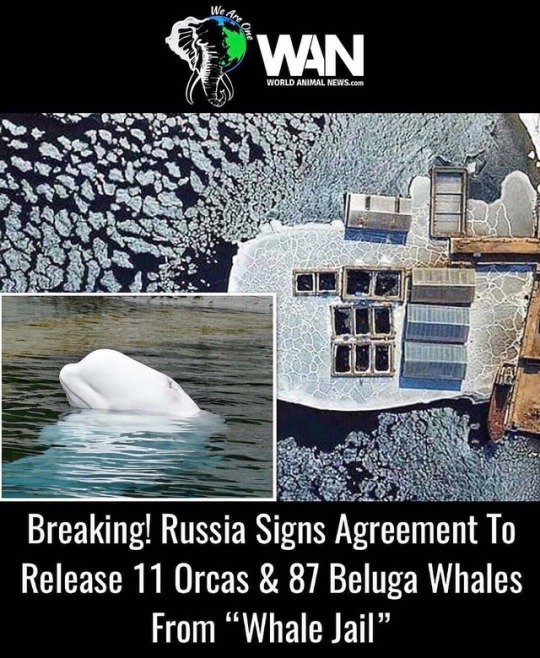
Reposted from @peace_4animals - Governor Oleg N. Kozhemyako of Russia’s Primorsky Region, #JeanMichelCousteau of @OceanFuturesSociety and Charles Vinick of The @WhaleSanctuaryProject signed an agreement today to release nearly 100 #whales that have been held captive in the #SrednyayaBay near the port town of #Nakhodka in #Russia’s Far East.🙏🐋 - As per the agreement, the “goal is to release the cetaceans back into their natural environment.” - - Both Russian and international marine wildlife experts from the Cousteau Team will continue to evaluate the #orcas and #belugas to determine when and how to release them. - READ MORE: 🌍👉WorldAnimalNews.com (LINK IN OUR BIO)👆@worldanimalnews_ @peace_4animals #WorldAnimalNews - #regrann https://www.instagram.com/p/BwCkk3xDyvP/?utm_source=ig_tumblr_share&igshid=2ervfawuivpe
0 notes
Text
North America's first whale sanctuary is taking shape in rural Nova Scotia
The plan to build North America's first wild refuge for whales retired from marine parks was poised to take a big step forward Friday in a remote corner of northeastern Nova Scotia.
The Whale Sanctuary Project is expected to officially open its visitor and operations centre in Sherbrooke, N.S., marking the first time the U.S.-based conservation group has moved from the planning phase to actually building something.
"It's a milestone," Charles Vinick, the project's executive director, said in an interview this week. "This really does show people that we are here, and we'll be cutting the ribbon to show this is in fact our home, here in Nova Scotia."
The new centre has been built in a renovated century home on the main street in Sherbrooke, a former timber and gold-mining town about 200 kilometres northeast of Halifax.
"It's a good opportunity for a new business to come into the municipality," said Greg Wier, the warden of the rural municipality that includes Sherbrooke. "For the most part, everybody is happy that it's coming ... I don't think there's any opposition."
Wier said the public wants to see whales in their natural environment rather than in captivity.
"There's a lot of public outcry for these whales being held in little pens," he said in an interview this week.
The proposed 40-hectare, coastal sanctuary -- to be enclosed by large underwater nets -- is expected to be built next year south of Port Hilford, N.S., a 20-minute drive southeast of Sherbrooke. It will be as large as 50 Canadian football fields and about 300 times larger than the biggest tank in any marine park.
The refuge could welcome its first whales in early 2023, assuming the project gets the required federal and provincial permits, Vinick said. It is designed to accommodate up to eight beluga whales, which he said can't be returned to the open ocean because of their lack of survival skills.
Despite public support, questions remain about the project, particularly when it comes to rough weather, the accumulation of whale waste and the potential for escapes.
Vinick said the site is well-protected from prevailing winds, an assertion partly based on his witnessing the arrival of two tropical storms in the past two years. As for the buildup of whale feces, he said a hydrodynamic study has shown the bay is regularly flushed by the currents and tides.
He also dismissed the possibility that the imported whales could transmit diseases to the resident whale population.
"The data suggest that those risks are extremely low," Vinnick said. "Generally, pathogens only are transmitted through physical contact, not through water-borne passage." The fact that migrating whales typically remain offshore means there will be limited interaction, he added.
Meanwhile, the non-profit group has started a campaign to raise up to $20 million for the project, which also calls for the construction of a veterinary clinic and interpretation centre near the refuge. Another $2 million would be needed annually for operations.
"We have a number of seven-figure donors who are very committed to this, and we're in discussions with others," said Vinick, who worked for 25 years with renowned undersea filmmaker Jacques Cousteau and his son Jean-Michel. The group is not asking for government funds.
About 200 belugas and 50 orcas are being kept in marine parks and aquariums around the world, though precise figures have been difficult to come by since entrepreneurs in China started building marine parks and importing whales from Russia. The Marineland Park in Niagara Falls, Ont., has about 40 belugas and Canada's lone captive killer whale, Kiska.
Public attitudes toward keeping these highly intelligent and socially complex animals in captivity have changed as researchers have learned more about their lives.
And the 2013 documentary "Blackfish" helped expose the darker side of the marine mammal entertainment industry by focusing on Tilikum, an orca involved in the deaths of three people. Ontario became the first province to ban the buying, selling and breeding of orcas in 2015.
The Vancouver Aquarium no longer keeps whales or dolphins in captivity. And in 2019, the Canadian government passed a law banning whales, dolphins and porpoises from being bred or held in captivity, though the law does not apply to the animals already living at Marineland.
The world's first whale sanctuary opened in southern Iceland in 2019. The Sea Life Trust has two belugas from China -- Little Grey and Little White.
This report by The Canadian Press was first published Oct. 29, 2021.
from CTV News - Atlantic https://ift.tt/2XTQnLc
1 note
·
View note
Link
0 notes
Text
Russia Says It Will Try to Free Almost 100 Whales Held in ‘Jail’

By NEIL MacFARQUHAR and IVAN NECHEPURENKO
Russian officials brought in two famous ocean experts, Jean-Michel Cousteau and Charles Vinick, to help determine how to release the young mammals.
Published: April 3, 2019 at 03:00PM
from NYT World https://www.nytimes.com/2019/04/04/world/europe/russia-whale-jail.html?partner=IFTTT
via IFTTT
0 notes
Photo
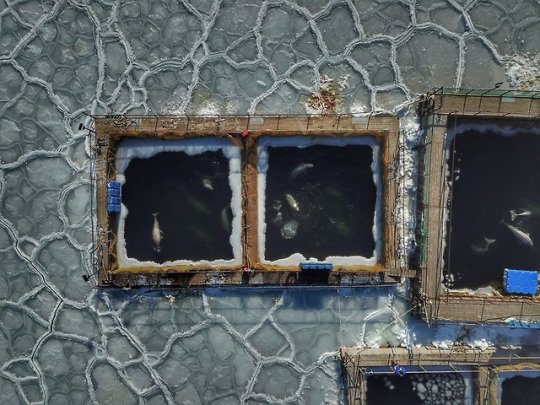
Russia Says It Will Try to Free Almost 100 Whales Held in ‘Jail’ by NEIL MacFARQUHAR and IVAN NECHEPURENKO By NEIL MacFARQUHAR and IVAN NECHEPURENKO Russian officials brought in two famous ocean experts, Jean-Michel Cousteau and Charles Vinick, to help determine how to release the young mammals. Published: April 4, 2019 at 01:00AM from NYT World via IFTTT
0 notes
Photo
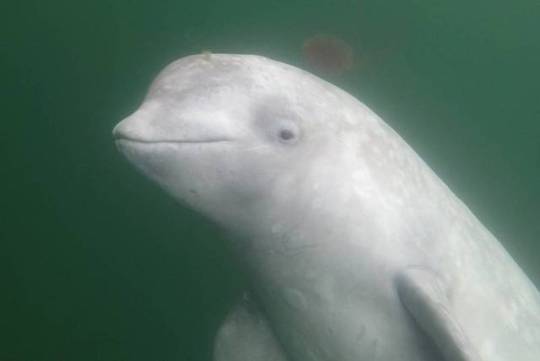
Whale group still fishing for Nova Scotia sanctuary site
John McPhee - January 29, 2019
A whale sanctuary group has changed tack in its ongoing search for a beluga protection area in Nova Scotia.
The Whale Sanctuary Project will hold public meetings over the next 10 days to identify communities that may be interested in becoming home to a seaside sanctuary for beluga whales being retired from entertainment parks.
Project organizers Charles Vinick and Lori Marino first floated the idea of a sanctuary in Nova Scotia last summer but the idea foundered in at least one community, Terence Bay, amid opposition from local fishermen.
This time around the group is emphasizing community input and consultation, said Vinick, who is best known for the Keiko Project, which marshaled public support to reintroduce to the wild an orca captured in Iceland and sold to Marineland in Niagara Falls, Ont., made famous in the Free Willy films.
“This is a different approach,” Vinick said in an interview Tuesday after a news conference in Halifax announcing the public meetings.
Last summer, the group focused on gathering information such as depth, water flow and other physical characteristics at potential sites identified through conversations with local individuals and environmental groups.
“We have a lot of data but we need to start with people and really start with the communities,” Vinick said, “and that’s what this approach is about so that we (aren’t) seen as coming in with a plan and having people adopt it but rather try to create a workable plan with a community that’s interested.”
Referring to Terence Bay, he said “the fishermen had legitimate concerns. ... They are reasonably concerned about anything that may impact their livelihoods so we want to be sure we create a situation that’s positive for them as well as for any other stakeholders in the community.”
Vinick also said there was confusion last year about the species his group had in mind for the Nova Scotia sanctuary. While the project wants to create sanctuaries for orcas and dolphins elsewhere, the Nova Scotia site would only include beluga whales.
The organization is looking for a 40-hectare area (just under 0.5 square kilometres) along the Atlantic shore of Nova Scotia that can become a home to whales that retired from entertainment facilities or are injured and need rehabilitation within a netted-off area. The project would create jobs and promote knowledge among local residents and visitors about the beluga, the group says.
Belugas raised in captivity aren’t capable of feeding themselves in the wild so they would spend all their lives (between 30 and 50 years) in the protected area.
“Because they depend so much on learning throughout their ... childhood-juvenile period, they’ve missed all that,” said Marino, a neuroscientist who has studied the evolution of the brain and intelligence in dolphins, whales, primates and farmed animals.
“They have no idea what an ocean is,” she said at the news conference in Halifax. “They have no idea what it means to survive and catch one’s own fish. They don’t have a social group, they don’t have survival skills so we can’t just take them and dump them back in the ocean.”
The group’s local adviser and site selection co-ordinator, Catherine Kinsman, said the priorities will be to find the most suitable natural environment for the belugas and just as importantly, the right community for the sanctuary.
“I have a particular understanding of beluga whales in our waters,” said Kinsman, a beluga research specialist who co-founded the Whale Stewardship Project about 20 years ago, “but also I know the incredible value and importance of communities ... It’s the community that needs to really understand the visitor that’s there in their waters and be able to adopt and adapt to (them).
“The community (must be) able to conduct their activities in the water so they can still do what they need to do, both recreationally and for fishermen, and yet keep the whale safe.”
The first public meeting will be held Thursday, Jan. 31, in Alderney Landing in Dartmouth at 7 p.m. Details on the February meetings in Liverpool, Port Hawkesbury, Sherbrooke and Sheet Harbour can be found on the project's website.
14 notes
·
View notes
Text
Russia Says It Will Try to Free Almost 100 Whales Held in ‘Jail’
Russian officials brought in two famous ocean experts, Jean-Michel Cousteau and Charles Vinick, to help determine how to release the young mammals.
Russia Says It Will Try to Free Almost 100 Whales Held in ‘Jail’ syndicated from https://triviaqaweb.blogspot.com/
0 notes